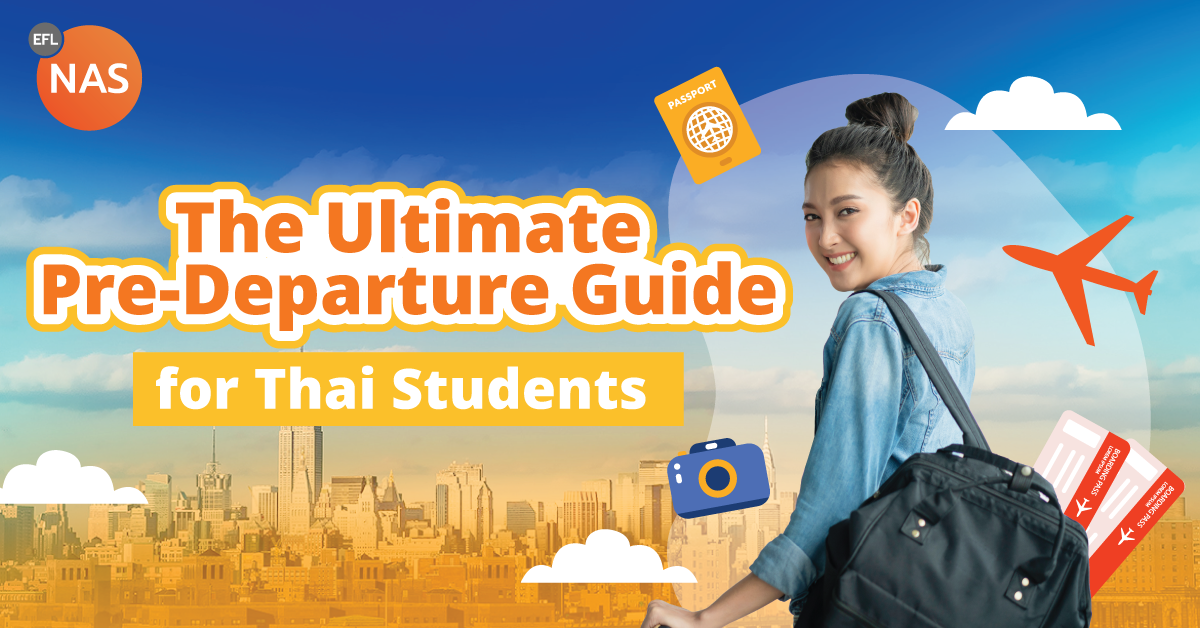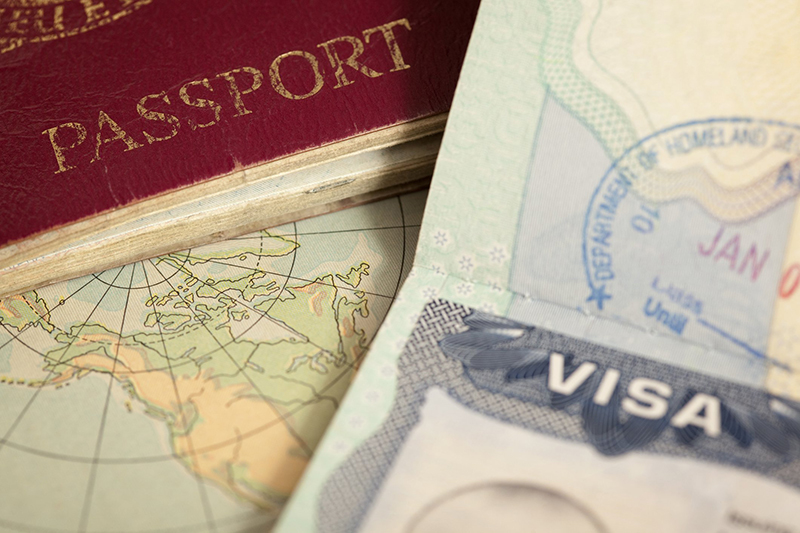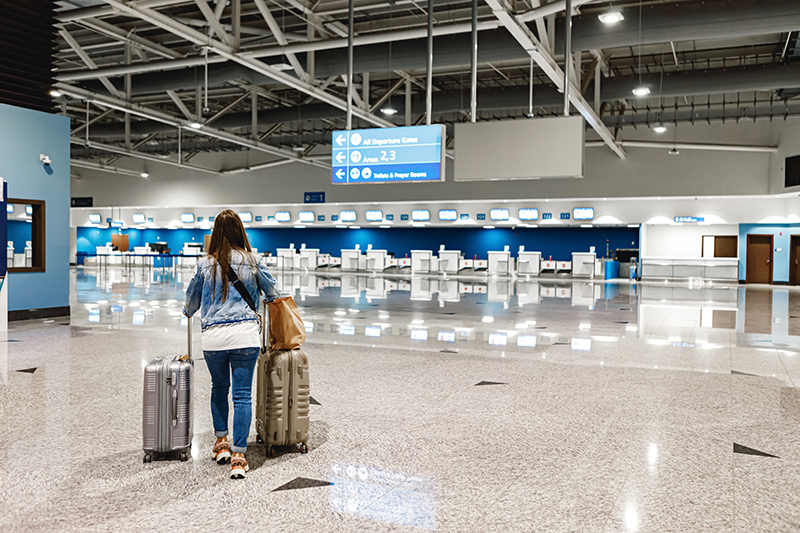
The Ultimate Pre-Departure Guide for Thai Students
Your Adventure Awaits! การผจญภัยของคุณกำลังรออยู่!
ขอแสดงความยินดีด้วย! ตอนนี้ คุณกำลังเตรียมตัวสำหรับการเดินทางที่น่าตื่นเต้นและเปลี่ยนแปลงชีวิตที่สุดครั้งหนึ่ง นั่นคือการไปศึกษาต่อที่สหรัฐอเมริกา เป็นเรื่องปกติที่จะรู้สึกตื่นเต้นและประหม่าในเวลาเดียวกัน นี่คือเหตุผลที่ North America Study ได้จัดทำคู่มือนี้ขึ้นเพื่อแนะนำทุกสิ่งที่คุณต้องรู้ก่อนออกเดินทาง
เรามาเริ่มกันเลย!
สิ่งสำคัญ – ทำความเข้าใจวีซ่านักเรียน F-1 ประเภท 1 ปีของคุณ

โดยทั่วไปนักเรียนไทยจะได้รับวีซ่านักเรียน F-1 แบบเข้าออกได้หลายครั้ง (Multiple-Entry) มีอายุ 1 ปี ซึ่งเป็นเรื่องปกติ ไม่ได้หมายความว่าคุณจะสามารถเรียนได้เพียง 1 ปีเท่านั้น การอนุญาตให้พำนักในสหรัฐอเมริกาอย่างถูกกฎหมายนั้นขึ้นอยู่กับเอกสาร Form I-20 และสถานะนักเรียนของคุณ ไม่ใช่วันหมดอายุบนหน้าวีซ่า ตราบใดที่ I-20 ของคุณยังไม่หมดอายุและคุณยังคงสถานะนักเรียนเต็มเวลา คุณสามารถพำนักในสหรัฐฯ ได้อย่างถูกกฎหมายแม้ว่าวีซ่าจะหมดอายุก็ตาม หากต้องการเดินทางกลับเข้าสหรัฐฯ หลังจากที่วีซ่าของคุณหมดอายุแล้ว คุณจะต้องยื่นขอวีซ่าใหม่ที่สถานทูตหรือสถานกงสุลสหรัฐฯ
เคล็ดลับ: ควรดูแลรักษา I-20 ของคุณให้เป็นปัจจุบันและมีการลงนามโดยเจ้าหน้าที่ DSO (Designated School Official) อยู่เสมอ
เช็คลิสต์เอกสารสำคัญก่อนเดินทาง (สำหรับกระเป๋าถือขึ้นเครื่อง)
ห้ามเก็บเอกสารเหล่านี้ไว้ในกระเป๋าเดินทางที่โหลดใต้เครื่องเด็ดขาด
ควรเก็บไว้กับตัวในกระเป๋าที่ถือขึ้นเครื่องตลอดเวลา
- หนังสือเดินทางพร้อมวีซ่านักเรียน F-1 ที่ยังไม่หมดอายุ
- เอกสาร Form I-20 (ลงนามโดยคุณและเจ้าหน้าที่ DSO)
- ใบเสร็จการชำระเงินค่า SEVIS I-901
- จดหมายตอบรับจากมหาวิทยาลัย
- หลักฐานทางการเงิน (รายการเดินบัญชี, จดหมายรับรองทุนการศึกษา)
การเดินทางถึงสหรัฐฯ – ขั้นตอนการผ่านด่านตรวจคนเข้าเมือง

ไปยังด่านตรวจคนเข้าเมืองซึ่งเจ้าหน้าที่ CBP (Customs and Border Protection) จะตรวจสอบเอกสารของคุณ
- ใจเย็นๆ สุภาพ และตอบคำถามอย่างชัดเจน
- ยื่นเอกสารตามรายการข้างต้นให้เจ้าหน้าที่
- เจ้าหน้าที่จะประทับตราลงบนหนังสือเดินทางและอนุญาตให้คุณเข้าเมืองในสถานะ F-1
- คุณสามารถตรวจสอบบันทึกการเข้าเมืองอิเล็กทรอนิกส์ (I-94) ของคุณได้ที่ https://i94.cbp.dhs.gov
การเงินและการธนาคาร
ควรพกเงินสดประมาณ $500 – $1,000 ดอลลาร์สหรัฐสำหรับค่าใช้จ่ายเริ่มต้น
เปิดบัญชีธนาคารในสหรัฐฯ ภายในสัปดาห์แรก (เช่น Bank of America, Chase หรือธนาคารในมหาวิทยาลัย)
ผู้ปกครองสามารถโอนเงินผ่านธนาคาร (Bank Wire) หรือใช้แอปพลิเคชันอย่าง Wise หรือ Remitly
จัดกระเป๋าอย่างไร? รายการของที่ควรจัดอย่างชาญฉลาด
ของที่ควรแพ็คไป:
- เสื้อผ้า: เสื้อผ้าที่ใส่ซ้อนกันได้ และควรไปซื้อเสื้อกันหนาวสำหรับฤดูหนาวที่สหรัฐฯ
- อุปกรณ์อิเล็กทรอนิกส์: แล็ปท็อป, โทรศัพท์, ที่ชาร์จ, หัวแปลงปลั๊ก (Type A/B, 120V)
- ของใช้ส่วนตัว: เครื่องใช้ในห้องน้ำ, ยารักษาโรคพร้อมฉลากภาษาอังกฤษ
- ของจากเมืองไทย: ขนมไทย, ของใช้ส่วนตัวที่สำคัญทางจิตใจ
- ของที่ควรไปซื้อที่สหรัฐฯ: เครื่องนอน, อุปกรณ์ครัว, เครื่องใช้ในห้องน้ำ, และตำราเรียน (แนะนำให้เช่าหรือซื้อมือสอง)
ประกันสุขภาพและการดูแลสุขภาพ

- ประกันสุขภาพเป็นสิ่งจำเป็นและมักจะรวมอยู่ในค่าเล่าเรียนแล้ว
- ความคุ้มครองจะเริ่ม ณ วันปฐมนิเทศหรือวันเปิดภาคการศึกษา
- ควรฉีดวัคซีนที่จำเป็นให้เรียบร้อยก่อนเดินทางออกจากประเทศไทย
สัปดาห์แรกของคุณในสหรัฐอเมริกา
- รายงานตัวกับสำนักงานนักศึกษานานาชาติ
- เข้าร่วมการปฐมนิเทศ
- เปิดบัญชีธนาคาร
- ซื้อซิมการ์ดของสหรัฐฯ (T-Mobile, AT&T, Mint)
- สำรวจมหาวิทยาลัยและร้านค้าใกล้เคียง
- ซื้อของใช้ที่จำเป็น
- ลงทะเบียนเรียนให้เรียบร้อย
How the North America Study Team Enriches Your Experience
ทีมงาน North America Study จะช่วยเติมเต็มประสบการณ์ของคุณได้อย่างไร
การเดินทางของคุณไม่ได้สิ้นสุดลงเมื่อเครื่องบินขึ้น แต่ในหลายๆ ด้าน มันเพิ่งจะเริ่มต้นขึ้นเท่านั้น
ทีมงาน North America Study ยังคงเป็นพันธมิตรที่พร้อมดูแลคุณเสมอ แม้ว่าคุณจะเดินทางถึงสหรัฐอเมริกาแล้วก็ตาม
เราพร้อมให้คำแนะนำเมื่อคุณเผชิญกับความท้าทายด้านการเรียน การปรับตัวเชิงวัฒนธรรมที่ลึกซึ้งขึ้น และช่วยคุณทำความเข้าใจเอกสารทางการจากมหาวิทยาลัย ความสำเร็จและความเป็นอยู่ที่ดีของคุณในระยะยาวคือสิ่งที่เราให้ความสำคัญสูงสุด คิดถึงเราในฐานะทีมสนับสนุนที่เข้าใจทั้งพื้นฐานและเป้าหมายของคุณ เราภูมิใจอย่างยิ่งที่ได้เป็นส่วนหนึ่งของการเดินทางของคุณ และพร้อมเสมอที่จะช่วยให้คุณประสบความสำเร็จอย่างงดงาม
Your Journey to the USA Starts Now!
Congratulations! You’ve worked incredibly hard to get to this point — from researching schools and submitting your applications to receiving your acceptance. Now, you’re preparing for one of the most exciting and life-changing journeys of your life: studying in the United States.
It’s normal to feel excited and nervous. That’s why we created this guide — to walk you through everything you need to know before your flight. From visas to packing, banking to culture shock, we’ll help you feel fully prepared and confident.
At North America Study, we’re with you every step of the way. Let’s begin!
Section 1: IMPORTANT – Understanding Your 1-Year F-1 Visa
A common concern we hear from Thai students is about the 1-year F-1 visa. Here’s what you need to know:
- Yes, Thai students typically receive a 1-year, multiple-entry F-1 visa. This is completely normal.
- This does NOT mean you can only study for 1 year. Your legal permission to stay in the US depends on your Form I-20 and your student status, not the visa expiration date.
- As long as your I-20 is valid and you remain a full-time student, you can stay in the US legally — even after the visa stamp expires.
- If you travel outside the US after your visa expires, you’ll need to apply for a new visa at a US Embassy or Consulate (usually in Thailand) before returning.
- Thousands of Thai students manage this every year — and you can too!
✅ Tip: Always keep your I-20 up to date and signed by your DSO (Designated School Official).
Section 2: Pre-Departure Document Checklist (Your Carry-On Bag)
Never pack these in your checked luggage. Always carry them with you:
- Passport with valid F-1 visa
- Form I-20 (signed by you and your DSO)
- SEVIS I-901 payment receipt
- University acceptance letter
- Financial evidence (e.g., bank statements, scholarship letter)
Section 3: Arriving in the USA: Immigration and Port of Entry
Here’s what to expect when your plane lands:
- Proceed to immigration where a CBP officer will review your documents.
- Be calm, polite, and answer questions clearly.
- Present the documents listed in Section 2.
- The officer will stamp your passport and admit you in F-1 status.
- Within a few days, access your electronic I-94 (arrival record) at: https://i94.cbp.dhs.gov
🛑 Important: Check that your I-94 says “F-1” and “D/S” (Duration of Status). If not, contact your school immediately.
Section 4: Finances & Banking
How much cash should I bring?
Bring around $500–$1,000 USD in cash for initial expenses (food, transport, SIM card, etc.).
Opening a U.S. Bank Account
Do this within your first week. Most students choose:
- Bank of America
- Chase
- Local credit unions near campus (often with student benefits)
You’ll need:
- Passport with visa
- I-20
- University ID or acceptance letter
Transferring Money from Thailand
Parents can use:
- Bank wire transfers
- International transfer apps (like Wise or Remitly)
- Some Thai banks partner with U.S. banks — check in advance.
Section 5: What to Pack? A Smart Packing List
✅ What to Pack
Clothing:
- Pack for the climate (check your university’s weather)
- Layering is key
- Winter coats, boots, and thermal wear can be bought in the US
Electronics:
- Laptop, phone, and chargers
- US voltage: 120V | Plug type: A/B → Bring plug adapters!
Personal items:
- Toiletries (small supply)
- Prescription medications with English documentation
- Glasses/contacts
Items from Home:
- Instant noodles, Thai seasoning, snacks (check customs rules)
- Small sentimental items (photos, Thai souvenirs)
❌ What to Buy in the US
- Bedding & pillows
- Kitchen supplies
- Toiletries (shampoo, soap, etc.)
- Textbooks: rent or buy second-hand online (Amazon, Chegg)
Section 6: Health Insurance & Healthcare
- Health insurance is required for all international students.
- Most universities automatically enroll you and include the cost in your tuition bill.
- Coverage typically starts from orientation or your program start date.
- Vaccinations: Get them done in Thailand before departure if possible — check with your school for specific requirements.
Section 7: Your First Week in the USA
Your First Week To-Do List:
- Check in with the International Student Office
- Attend international student orientation
- Open a bank account
- Get a US SIM card (T-Mobile, AT&T, Mint Mobile)
- Explore your campus and nearby stores
- Buy supplies (bedding, toiletries, school items)
- Finalize class registration
Section 8: A Note on Cultural Adjustment
It’s completely normal to experience culture shock or homesickness. Be patient with yourself.
- Keep an open mind
- Join student clubs and activities
- Practice your English
- Stay connected to family (but don’t isolate)
- Use campus counseling services or peer support programs if needed
💬 Remember, every international student goes through this — you are not alone.
Conclusion & Final Checklist
You are about to begin one of the most exciting chapters of your life. Studying in the US is not only about academics — it’s about growth, independence, and new experiences.
We’re so proud of you. 🎉
Here’s your final pre-departure checklist:
- F-1 visa and documents in your carry-on
- Flight booked
- US address prepared (for arrival forms)
- School and North America Study contacts saved
- Packed smartly
- Informed your bank of international usage
- Downloaded key apps (Google Maps, translation apps, etc.)
📞 Need help?
North America Study is always here to support you.
Phone: +66 2-821-5500
Line: @EFLNA
✈️ Safe travels — your American journey begins now!
สนใจเรียนต่อที่อเมริกาติดต่อทีม North America Study ได้เลย! 🤝
ข้อมูลเพิ่มเติม เรียนต่อป.ตรี (Bachelor) อเมริกา คลิ๊ก!!
ข้อมูลเพิ่มเติม เรียนต่อป.โท (Master) อเมริกา คลิ๊ก!!
